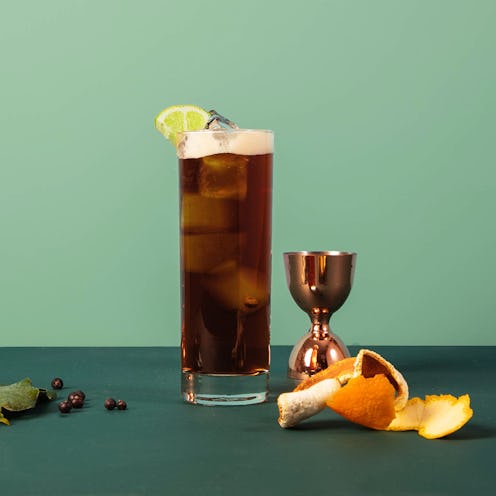Life
Starbucks’ Newest Drink Mixes Coffee & Gin In A VERY Cool Way

If you've been concerned that your morning coffee order has become a bit too basic for your palate, you're going to want to know what Starbucks' new Gin Barrel-Aged Cold Brew coffee is — because basic is not a word you can use to describe it. While Starbucks' has already dipped their toes into the fancy cold brew landscape with drinks like the Cascara Cold Brew and the Reserve Nitro Cold Brew, this new drink is next level. Here's why: it's made with the same barrel-aging process that gin uses, which gives it a complex flavor — making it perhaps the most extra cold brew on the market in the best possible way.
Wondering where Starbucks is gin barrel-aging their coffee beans? Well, first things first, there is some bad news: This coffee is only available at one Starbucks location. No, unfortunately the barrels are not hiding behind the counter at your local neighborhood location — they're actually only available at the Starbucks Reserve Roastery in Seattle, WA, where the beans can be made in small batches and served to the most ambitious of coffee lovers. In other words: You'll have to take a trip to Seattle to try this drink. It's there that the Rwandan coffee beans are hand-rotated in the oak barrels — which are sourced from a local Seattle craft distillery, Big Gin, and previously from a bourbon distillery — to absorb a variety of flavors. Over the course of a few weeks, the beans take on the flavors of the bourbon, the gin, and the oak barrel char, to conjure a sweet and spicy flavor profile similar to pepper, cardamom, and vanilla.
Once the beans are fully seasoned by the process, they are roasted in small batches by a class of "master roasters" at the Starbucks Reserve Roastery. The roasting process burns off all of the alcohol from the gin — this is a morning drink for all ages, after all — but keeps the aromas that are collected during the initial barrel-aging process. The result? The coffee retains some of the gin's citrus flavoring, and takes on a smooth taste of caramel as well.
And it's not hard to imagine, either. When you think about the extended process that goes into making this beverage, it's easy to understand the complex flavoring and why this drink will stand out as a truly artisan endeavor for the chain coffee roasters.
If you've ever had a barrel-aged spirit before, you can recognize it thanks to its oak and spiced flavors — so if you imagine that level of seasoning being attributed to your morning coffee, it's easy to understand why this is such a game changer. Barrel-aging has been around for thousands of years — it's a storage method most commonly used for spices and spirits — but coffee bean barrel-aging is a slightly newer process. Kind of. According to The Spruce, in the 1500s, when coffee beans first arrived in Europe, they arrived in barrels as aged beans. Back then, the fact that they were aged had more to do with storage and lengthy shipping times — but by the 1800s when faster shipping was available and fresher beans could be offered, people still preferred the aged beans for their flavors.
Since then, various distilleries have played around with aging coffee beans in their barrels, and there are niche pockets of people all over the world who know and favor barrel-aged coffee beans. But it's only been in the last few years that the trend is making its way to mainstream American coffee consumption. And while having this process arrive at Starbucks is certainly a giant leap into the mainstream coffee market, it's still slightly niche as the drink will only be available at the Reserve Roastery in Seattle, a perfect balance of introducing it to the American cold brew lovers, while keeping it special still, too.